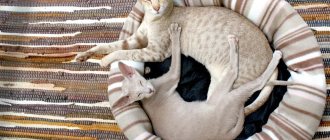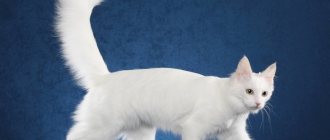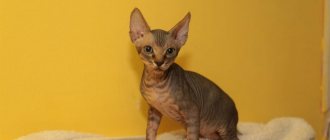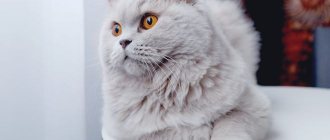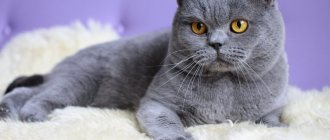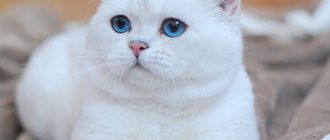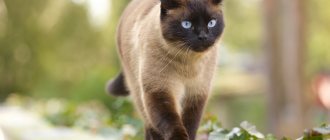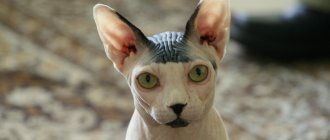History of color appearance
At the beginning of the twentieth century, cinnamon was known in the Abyssinian cat breed. In those days, red cover was not yet called sorrel. Cinnamon for British cats appeared quite recently and is still considered quite rare. Scientists studying the genetics of red color in a variety of cat species have learned that the sex of the animal has a big influence. It is also interesting that the Abyssinian coat genes have nothing to do with inheritance linked to the sex of the pet.
Maria Falkena is a breeder from Holland who, in the early 60s of the 20th century, imported a couple of red Abyssinians from Britain. The male and female cat, named Delilah and Sothis, were purchased from Dorothy Windsor, where she usually acquired her Falken pets. At that time, cats with red fur had not yet been seen on the continent, so the breeder thought that this pair of animals were also red.
However, outwardly they did not look like that at all. Usually cats with red fur have a reddish tint to their fur, but this couple had it brownish-red, like foxes. Among felinologists, Fakena was quite famous for her willingness to experiment and her curiosity. Since her kittens did not look red, she decided to find out if they were in fact genetically red. So, Maria Falkena bred Dilila with a wild-colored cat called “Nigella Simba.”
The couple gave birth to kittens and the real discovery was baby Iris, who had a previously unknown fur color. In reality, Iris should have been born tortoiseshell if her mother had been genetically red. The researcher could not find an explanation for this color, even after reading mountains of literature. In April 1980, the independent club NKFV recognized the kittens as “foreign shorthaired”. Interestingly, in British kittens, breeding cinnamon-haired owners is a difficult matter, due to the recessiveness of the trait.
Who is not recommended to have an ori?
You should not have a pet of this breed if you:
- Do you plan for your pet to spend half the day alone while you are at work?
- You don’t have the strength, patience, desire and time to educate an Oriental.
- Don't like cats that are always nearby and prefer those who are on their own.
- You don't like talkative animals; loud noises irritate you, and you prefer peace and quiet.
- Spend part of your time on the road or move frequently.
Features of color
Cinnamon is a rare and new coat color in cats, it has warmer tones than chocolate coat color.
It appeared due to the oxidation of melanin by the bl gene. The paw pads of such cats and cats become pinkish-brown, almost beige, as does the nose. Cinnamon is a much lighter color than chocolate, rarely with a brownish-reddish sheen. It often happens that a chocolate kitten’s fur is slightly lighter than that of an adult cat, which can be seen in the photo below.
The breeder is happy that he was lucky and a cinnamon was born. There's really no need to rush if the animal's paw pads and nose are brown. Cinnamon is classified as an undiluted color D, while its lightened version is called faun or “fawn.” Next in the video we offer you to look at the owner of such wonderful fur.
Differences from similar colors
It often happens at shows lately that cats from a red coat could be converted to cinnamon. This can once again prove that it is complex and popular. However, in this case, the question may arise as to how judges distinguish cinnamon from other coat colors in kittens. Cats that can be classified as red coats have a red coat and an orange undercoat. Lighter cats can boast a beige undercoat.
Darker pets may have a brick-gray coating on their paws, tail, chin, and so on. That is, in places where there is less undercoat and the hair itself is shorter. The rims of the lips and eyes, as well as the paw pads of red cats should be pink when at rest, this can be seen in the photo below. And if the pet is nervous, then they can be from a light shade to red. Cinnamon has a red-brown coat, with a brown-yellow undercoat.
At the same time, the red tone of the fur can be copper, in some cases even bronze, but not orange, like red kittens.
In a cinnamon animal, the rims of the lips and eyes, the pads of the paws and the mirror of the nose should be almost white; it is allowed for a pinkish sheen to be present on it.
Definition and a bit of genetics
Cinnamon color appeared relatively recently and is a rare color. The bearer of such an unusual color is the British cat breed. Sometimes you can hear how the color is also called cinnamon, which comes from the word cinnamon. This is not surprising, since the fur is reddish-brown. This color is usually classified as black-brown, determined by the pigment eumelanin.
If we look at the situation from a genetic point of view, then the formula contains a dominant allele B - black , thanks to which it is possible to guarantee the production of a dark pigment. When animals have it, the fur coat is painted in classic colors. We are talking about black or blue. In the latter case, dilution occurs due to the D gene, which is responsible for color dilution.
In this regard, the hair of the coat is poorly filled with eumelanin molecules, which leads to a gray-blue color. When the B – brown allele is additionally present in the color, the color of the animal will be either chocolate or diluted. Lilac color is not uncommon and is even more common than chocolate. At the same time, the presented allele affects the fact that the black pigment is, as it were, displaced from the general structure. This affects the lightening of the brown tone.
Several decades ago it turned out that there is another alley responsible for the color of the coat, its name is BL - brown light - light chocolate. Thanks to it, you can get the cinnamon color in cats.
Characteristics of cinnamon cats
The character of Cinnamon cats can be praised endlessly because it is too pleasant. Their level of intelligence is constantly debated, with cinnamon constantly receiving approval. These cats are unobtrusive and moderately curious. With all this, cinnamons are absolutely calm, shy and charming, just look at the photo below. The pet easily adapts to any living conditions: be it other animals or loneliness.
Care
Wool
Oriental wool is very easy to care for. Their short and smooth coat does not require daily brushing. It is shiny, fits tightly to the body and does not shed as often as other cats. Orientals have no undercoat.
The Oriental's fine fur does not pick up much dirt and debris, so there is no need to bathe it often, otherwise you can damage the coat by removing the protective sebum on its skin.
It is better to clean the fur with soft silicone brushes; this should be done no more than once every 4 weeks. The animal's ears and eyes require care, mainly wiping with lotion and periodic examination for abnormalities in ear and eye discharge.
Nutrition
Orientals are not prone to overeating, so you can leave dry food available to your pet at all times. At first, kittens eat often, later they choose their own diet. You can see our rating of dry food for adult cats here.
It will be enough on your part to keep the food and water bowls full at all times.
Important! Some nurseries practice mixed nutrition. If your kitten is from such a nursery, then it may need to be additionally fed with meat or dairy products. Be sure to consult your breeder when choosing food for a kitten.
Walking your pet
Orientals are well kept in apartments. They do not suffer from lack of walking on the street or in the garden. Walking your pet is possible on a leash.
If your cat does not wear down its claws on walks, then you definitely need to install a scratching post in your apartment and train it to use it. Like any other useful habit, it is better to start learning from an early age.
How to get Cinnamon colored kittens?
The synthesis of the melanin pigment is carried out by the B gene, this is how the future color is determined in the body. The normal form of the pigment (black) is formed by a dominant allele, and the oxidized one, that is, chocolate, is formed by a recessive allele. Gene B also has an allelic series, which means that in addition to the chocolate and black coat alleles, there is also a more recessive black allele, which forms a highly oxidized form of eumelanin. In the case when a heterozygote and a homozygote with allele B will have a black coat, then a homozygote with allele b will form a chocolate-colored coat. As a result, a cat with the blbl genotype will have a warm coat of brownish-red color, which is called cinnamon, as in the photo below.
BRITISH CINNAMON: PHOTOS OF ADULT CATS
Photos of British cats, cinnamon color.
| In our cattery you can “buy a real British kitten.” We have many different colors, we will help you choose and answer all your questions! |
Pros and cons of the breed
Reviews from owners of Oriental breed cats sound predominantly positive. But some owners are not prepared for the fact that oriental pets express emotions too loudly, and consider this a powerful argument for transferring the animal to other hands.
Oriental cats cannot be called ideal pets, because they have both advantages and disadvantages:
| pros | Minuses |
| Exotic appearance | Touchiness |
| High intelligence | Excessive devotion bordering on addiction |
| Sociability |
Oriental cats are beautiful animals that visually resemble alien creatures. Their exotic exterior, complemented by their talkative nature and playful disposition, makes them ideal pets for those who are willing to devote maximum time and attention to them.
Oriental cat (Oriental Shorthair)
Oriental is a cat breed officially recognized in 1977 in America. Distinctive features are a long slender body, refined bones and strong muscles, a wedge-shaped head, expressively large ears, a thin long tail, playfulness, talkativeness, a friendly character, and affection for humans.
Belongs to the Siamese-Oriental breed group.
History of the breed
At the end of the 19th century, the predecessors of modern Oriental cats, along with Siamese cats, were imported from Thailand to England. The Encyclopædia Britannica (11th edition, 1903) mentions fully colored Siamese cats.
Until 1923, controversy continued over solid-colored animals and their exhibition careers, until the Siamese were completely excluded from the Siamese class and, accordingly, the creation of the breed.
In 1956 Mrs. Elsie Quinn (Quinn Cattery, California) imported the Havana Brown Roofspringer Mahogany Quinn from England, which is the progenitor of this breed in America. In 1958, a provisional standard was adopted, and on July 11, 1964, the Havana Brown breed received champion status in the CFA.
American breeders registered the chocolate-colored oriental cat as an independent breed, Havana Brown, thereby preserving the original type and uniqueness of this cat. In America, "Havana Brown" is not just a color, but also a distinctive breed type that was lost in Europe due to co-breeding with Siamese cats and constant improvement.
American breeders began a campaign for recognition of other colors of solid Siamese cats, and achieved full recognition in 1977. Taking the standard of the Siamese cat as a basis, they made minor but very far-sighted changes to it (the word “medium” in the description of the head and body was replaced by “long”) and at the same time developed a program for working with colors.
In 1995, two-color colors, the so-called, were recognized in the Oriental breed. bi-colors. Breeders, by analogy with the Javanese and Balinese, introduced the Longhair gene into the breed. Longhaired Orientals received CFA Championship status in 1997.
General impression
A slender, flexible cat, with long, refined lines, very graceful and at the same time strong, with well-developed muscles in excellent physical condition. Not loose or bony. No signs of obesity. The eyes are brilliant. Representatives of the longhair division give the impression of cats with softer lines and a less extreme type than representatives of the shorthair division.
Appearance
The head is a long tapering wedge. The wedge starts from the nose and diverges in straight lines to the bases of the ears, forming a triangle without interruption in the ear pads. The distance between the eyes is not less than the width of the eye. If the whiskers (and facial hair in the longhaired division) are smoothed back, the bony structure of the head becomes visible. The skull is flat. In profile, a long, straight line can be seen from the crown of the nose to the tip of the nose. No bulge in the eye area. Without lowering the nose line.
The nose is long and smooth, continuing the line of the forehead without a break. The muzzle is sharp, wedge-shaped. The chin and jaws are of medium size. The tip of the chin forms a straight vertical line with the tip of the nose. Not slanted and not overly massive. The ears are expressively large, wide at the base, rounded, continuing the line of the wedge of the head. The eyes are almond-shaped, medium in size, set obliquely and inclined towards the nose in harmony with the lines of the wedge and ears. Not rolled out, but not sunken either. No squint. The body is long and slender. A characteristic combination of refined bones and strong muscles. The shoulders and hips continue the straight lines of the tubular body. Hips cannot be wider than shoulders. The stomach is taut. Males can be larger than cats. The neck is long and slender. The legs are long and slender. The hind legs are higher than the front legs, in good proportion to the body.
The paws are graceful, small, oval in shape. The tail is long, thin at the base, tapering to a pointed tip. In the long-haired division, the hair on the tail is long, guard, and flowing.
The coat , in the shorthair division, is short, fine, shiny, satiny, lying close to the body. The coat, in the longhair division, is of medium length, fine, silky, without soft downy undercoat, lies close to the body and looks shorter than it actually is. The longest hair is on the tail.
Character
Orientals are friendly, love to travel with their owner and participate in all his affairs, are attached to a person, and cannot stand loneliness. They are sociable, expressing their emotions through behavior and voice - from quiet purring to loud meowing. They have a playful disposition, retain a love of games until old age, know how to attract attention, can fetch a ball, love to run, have fun and chew furniture.
Myths about the breed
Loud, unpleasant voice - its presence depends on the character of the particular representative of the breed. All Orientals are more talkative than representatives of other breeds, but an unpleasant harsh voice is as rare as in humans.
Climbing on curtains is characteristic of Orientals only in childhood; in adulthood, the desire to climb on curtains is no more characteristic of Orientals than of cats of other breeds.
Colors
Orientals are varied in color and pattern. Colors are divided into color groups solid (solid), shaded (shaded), smoke (smoky), parti-color (tortoiseshell), bi-color (bi-color) and tabby (tabby).
Colors
Ebony (black). The fur is black all over the body from the tip to the root of the hairs. The tip of the nose and paw pads are black. Eyes are green.
Havana (chocolate). The coat is a rich, warm chestnut-brown tone with uniform hair color from tip to root. The nose is brown, the paw pads are pink-brown. Eyes are green.
Lilac (lavender). A color that is difficult to describe verbally. The coat is a warm pinkish-gray color with a touch of gray or “frost”, without blue. The nose and paw pads are lavender (lavender). Eyes are green.
Blue (gray). The coat is blue (gray with a hint of blue), light to medium rich, evenly colored from root to tip. Preference is given to lighter shades of blue. The nose and paw pads are blue. Eyes are green.
Cinnamon (brown). Light brown coat color. The nose and paw pads are light brown, almost pink. Eyes are green.
Faun (beige). Light gray coat color with beige or pink tints. The nose and paw pads are pink. Eyes are green.
Red (red). The coat color is warm red, without other shades or patterns. The nose and paw pads are pink. Eyes are green.
Cream (light red). Coat color is pastel. Dark tones in color are undesirable. The nose and paw pads are pink. Eyes are green.
Drawing options
Solid (solid). The coat should be evenly colored from the base to the tips of the hair, from the tip of the nose to the end of the tail.
Shaded (darkened). The shaded colors have a white undercoat with a black tipping cape. The darker color on the back fades into a lighter color on the sides, face and tail and becomes completely white on the chin, chest, belly and underside of the tail.
Smoke (smoky). A color variation when, with the main or tortoiseshell color, the lower part of the hairs remains unpainted and white. When at rest, the animal appears to be of primary color. The white undercoat is clearly visible in movement. The limbs are painted with a basic color with a narrow white stripe at the base of the hairs, which can only be seen by parting the fur. The tip of the nose and paw pads correspond to the basic tone.
Parti-Color (tortoiseshell). The main color with patches of red or evenly mixed main and red colors on the body and limbs. The presence of several shades of red is acceptable. Preference is given to an even distribution of spots in the color.
Bi-Color (bi-color). The color is as described for the base color with the addition of white paws, legs, belly, chest, muzzle and an inverted “V” patch on the face. The eyes are green, blue, differently colored.
Tabby (tabby). Color with any pattern. There are marbled, spotted, brindle, ticked. Any of the smooth colors can be overlaid with a pattern. All tabby colors are characterized by certain identical elements - an M-shaped pattern on the forehead, continuous thin lines running from the outer corner of the eye to the back of the head, 2-3 curls on the cheeks, several closed rings and two rows of large dots on the neck and upper chest , running from the chest to the stomach. The limbs and tail are evenly covered with rings. The nose and eyes are outlined with a rim.
Marble. Thin lines run from the top of the head to the shoulders, where they form a butterfly-shaped pattern. Three continuous parallel lines run along the entire back from the pattern on the shoulders to the base of the tail. Large spots on each side are surrounded by one or more dense circles - these elements of the design should be symmetrical. All elements of the design are rich, thick in color and clearly defined.
Spotted. The elements of the pattern are divided into spots, preferably numerous in number, and in shape - round, oval or in the form of a rosette. The stripe on the back is also divided into spots.
Brindle (striped) . A narrow solid line runs along the back from the back of the head to the base of the tail. The rest of the body is striated with continuous thin lines running down the sides from the spine.
Ticked. Each hair of the fur, along its entire length, is colored with alternating dark and light rings of the main and contrasting colors (the more there are, the better). The body, when viewed from above, does not show any spots, stripes or stains, with the exception of a darker shade of fur on the back.
Silver Tabby A color variation where the main or tortoiseshell tabby color has a lighter silvery hue. A more contrasting pattern is desirable. The eyes and tip of the nose are edged. The nose and paw pads correspond to the main color.
Special color
White - the coat is completely white without any yellowness.
There are 3 types of white orietals:
- White with green eyes is an Oriental cat with a solid white coat.
- White color with blue eyes is a cat of the Siamese breed, as is customary in the rules of most felinological associations. In fact, blue eye color in white cats can appear under the influence of the W (White dominant) allele. A kitten may be born with or without a small spot (“cap”) on its head. If a white blue-eyed cat did not have a “hat” in childhood, then conclusions about its genetic belonging to the Siamese breed can only be drawn by crossing with Siamese cats.
- White color, eyes of different colors, one green, the other blue - this is an oriental with different eyes.
With a white color, up to 1 year there may be a colored spot on the head, which then disappears. The tip of the nose and paw pads are pink. The eyes are blue (foreign white), green or of different colors (one is blue, the other is green).
Brief history of the breed
Graceful cats belonging to the Siamese-Oriental group lived exclusively in Thailand for a long time and were not exported beyond its borders. In Europe they learned about them only in the 19th century. True, British felinologists mistook green-eyed Oriental cats for Siamese with a non-standard color.
Due to the “wrong” coat color and iris color, they were disqualified from exhibitions for a long period. Therefore, until the beginning of the 20th century, only real enthusiasts were engaged in their breeding.
In 1923, the American Siamese Cat Club imposed a strict ban on the use of any individuals for breeding purposes, with the exception of those with blue eyes and Himalayan coloring. For three decades, no one studied orientals.
Cats were only remembered in the 1960s. American and British breeders came up with the idea of creating a new breed that would be distinguished by its uniform color and graceful body lines. To achieve their goal, they began to cross Orientals with Abyssinians and other short-haired cats.
In 1977, the breed received its own standard, which was an exact copy of the characteristics developed for the Siamese, with the exception of the points “colors” and “body”. Oriental cats received recognition from British felinologists only in 1997.
Vaccinations and antiparasitic treatment
To protect the Oriental from viral diseases, it is systematically vaccinated with a complex drug that produces immunity:
- to panleukopenia;
- rhinotracheitis;
- calcivirus.
The first vaccination is given at the age of 7-8 weeks. After 4 weeks, the kitten is vaccinated against the same diseases and rabies. Subsequently, the oriental is vaccinated once a year.
To prevent diseases carried by parasites, the cat is regularly treated for fleas and worms. Anthelmintic drugs are given to the Oriental 2 times a year with mandatory repetition after 10-14 days.
A cat of this breed is treated against fleas with drops or shampoos. And if she regularly goes outside, she is additionally protected with an anti-parasitic collar.
Character and temperament
Oriental cats are endowed with an affectionate and absolutely non-aggressive disposition. Representatives of the breed quickly become attached to their owners and do not tolerate loneliness well. An important characteristic of Oriental cats is devotion, which borders on dependence. Therefore, when they find themselves in another family, adult representatives of the breed suffer greatly and even become depressed.
On a note. Orientals are very talkative creatures. Cats of this breed have a habit of responding with their loud, specific voice, as if maintaining a conversation.
Orientals are very inquisitive. They can sit on the windowsill for hours, watching everything that happens outside. Curious oriental cats are drawn like a magnet to closed drawers and cabinets. They will try to get inside by any means to study their contents.
Like the Siamese relative, the Oriental cat is very touchy and will in every possible way demonstrate indifference and disdain towards the offender.
Representatives of the breed get along well with children. Due to their non-conflict nature, Orientals are patient with childish pranks and will never offend children. True, this does not mean that cats of this breed will allow the inviolable boundaries of personal space to be violated.
Orientals are not characterized by aggression. Therefore, oriental cats get along without problems in the same territory with other pets, especially with those with whom they grew up.
Feeding the cat
The Oriental cat breed does not belong to the category of those whose food you can save on. It is advisable to feed such animals with high-quality industrial food of super premium or holistic class.
Products from the following brands are best suited for Orientals:
- Bosch;
- Orijen;
- Acana;
- Farmina;
- Brit Care.
When feeding natural products, the diet of a cat of this breed is designed so that it is dominated by fresh, lean meat. Orientals are also given:
- lean sea fish;
- offal;
- porridge with water;
- boiled vegetables;
- dairy products;
- eggs.
It is strictly forbidden to feed oriental cats with sweets, pastries, sausage, bones, pork, pickles, smoked meats and any leftovers from the master's table.
On a note. Orientals who eat natural foods are recommended to be given vitamins twice a year. Calcium supplements are recommended for kittens and young animals.
